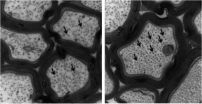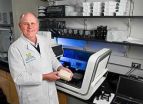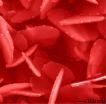(Press-News.org) Cold Spring Harbor, NY -- A team co-led by neuroscientists at Cold Spring Harbor Laboratory (CSHL) has shed light -- literally -- on circuitry underlying the olfactory system in mammals, giving us a new view of how that system may pull off some of its most amazing feats.
It has long been known from behavioral experiments that rodents, for instance, can tell the difference between two quite similar odors in a single sniff. But in such instances, what precisely happens in the "wiring" leading from sensory neurons in the nose to specialized cells in the olfactory bulb that gather the signals and transmit them to the brain? How can this occur within the brief span of a single respiratory cycle -- one inhalation and one exhalation?
Using a new method of exploring this question, CSHL scientists, in collaboration with researchers at Harvard University and the National Centre for Biological Science in Bangalore, India, have assembled evidence suggesting that the olfactory bulb in mice is not merely a relay station between the nose and brain, as many have supposed. Their data, published today in Nature Neuroscience, indicates that "there are many more information output channels leaving the olfactory bulb [en route to the cortex] than the number of information types entering it," from sensory receptors in the nose.
This complexity in sensory coding, which the team speculates may help the brain rapidly make highly accurate odor distinctions, became evident when the team used beams of light to activate highly specialized cells within the olfactory bulb, as prelude to measuring their electrical activity during single respiratory cycles.
Using beams of light to trace the circuit
The first step of the investigation involved using genetic engineering to generate a line of mice whose sensory neurons expressed a gene borrowed from a kind of algae that make them fire when beams of light are focused upon them. The algal gene expresses a photoreceptor protein called channelrhodopsin-2 (ChR2).
"We did this, when I was still at Harvard, in Venki Murthy's group, to overcome a problem that has limited olfactory circuit measurement in the past," says Florin Albeanu, Ph.D., a newly appointed assistant professor at CSHL who co-led the investigation. "Previously, we would have tried to insert electrodes into the olfactory bulb of the mouse. This is a bit like flying blind -- you can record the electrical activity of any cells you happen to hit, but you had no way of controlling which cells you would be recording from. Ashesh Dhawale, whom I met at a CSHL course on advanced imaging methods three years ago, and I decided to use light stimulation of the sensory neurons coupled with electrical recordings from the output neurons of the bulb to solve this problem."
The cells Albeanu, Dhawale and colleagues wanted to monitor are called mitral cells. These specialized cells are the final "broadcasting" stations for messages to the mouse's cortex that start out when neurons in the nasal epithelium sense an odor. Each sensory neuron is specialized to express a single molecular odor receptor type, from among some 1500 in a mouse's olfactory palette. Cells with the same sensitivity report their signals to a single specialized spherical unit -- literally a ball of synapses -- in the mouse's olfactory bulb. These collecting stations are called glomeruli.
The glomeruli each have about 15,000 axons feeding into them, and each, in turn, signals via primary dendrites to mitral cells. One glomerulus may be connected to as many as 30 mitral cells, all of which are also located in the olfactory bulb. Mitral cells also sport secondary dendrites, fibers which connect them laterally with one another via reciprocal synapses that link them to inhibitory local interneurons. By directly activating glomeruli in the olfactory bulb with tiny beams of light, the team was able to identify mitral cells with great specificity.
Explaining 'sister' cells in and out of synch
They were able to target -- and record electrical signals (action potentials) -- from mitral cells that they call "sister cells," whose responses on average are quite similar. This stands to reason because sister cells, by definition, receive information via primary dendrites from the same glomerulus. The scientists were also able to identify and monitor activity of "non-sister" mitral cells, ones whose firing activity is fundamentally dissimilar because of the comparatively wide contrast in the odors that their glomeruli report.
Perhaps the most interesting and surprising finding of the electrical recordings obtained in this fashion is that sister mitral cells, although they are connected to the same glomerulus, do not respond redundantly when a mouse is presented with an odor to which the glomerulus is responsive. In fact, says Albeanu, "we observed that odors de-synchronize pairs of sister mitral cells. This is something we did not expect."
How to explain this? The team formed a hypothesis based on comparisons of recordings made of the activity of many pairs of sister and non-sister mitral cells. According to Albeanu, "We thought of two metrics of activity with which to compare sisters and non-sisters. One kind compares the number of times cells fire in a single respiratory cycle; the other compares the intervals between their firing 'spikes,' and more specifically the points at which they occur relative to the start of a respiratory cycle.
"In other words, we looked at the rate of their firing, and compared it, in the same cells, both sisters and non-sisters, to the timing of their firing," says Albeanu. The team found that in sister cells, when the rate of firing changed in one sister, it changed in a similar manner in the other sister. But the timing of their firing differed -- instead of firing at the same moment, they fired asynchronously.
"This leads us to believe that two types of code are being utilized -- it's as if mitral cells are capable of conveying two different kinds of information to the cortex, and that they do so by multiplexing rate and time codes in the same message," according to Albeanu.
More information = more accurate odor representations?
These independent channels, the team speculates, might convey to the brain two different things. Changes in the rate of firing, they say, reflect the information coming from a glomerulus that sisters share. This very specific information is accompanied by an independent message that may reflect the average of the outputs of glomeruli in the general region, or "surround," of the specific glomerulus that the sisters share. These would be the product of information exchanged via the lateral connections between mitral cells with different lag times in firing, which the scientists call latencies. Broadcasting to the cortex on these two channels "would give the cortex more information with which to discriminate the odor that has been sensed," Albeanu says.
In future studies the scientists plan to systematically explore the effect of changing odor concentration on the rate and timing properties they have already observed. They have also already started to use the mouse line they created with light-sensitive olfactory sensory neurons in behavioral studies that may shed light onto what spatio-temporal rules govern odor coding at the level of the olfactory bulb.
INFORMATION:
"Non-redundant odor coding by sister mitral cells revealed by light-addressable glomeruli in the mouse" appears in Nature Neuroscience on October 17. The authors are: Ashesh K. Dhawale, Akari Hagiwara, Upinder S. Bhalla, Venkatesh Murthy and Dinu F. Albeanu. The paper can be found online at: http://www.nature.com/neuro/index.html
Cold Spring Harbor Laboratory (CSHL) is a private, not-for-profit research and education institution at the forefront of efforts in molecular biology and genetics to generate knowledge that will yield better diagnostics and treatments for cancer, neurological diseases and other major causes of human suffering.
For more information, visit www.cshl.edu
Optical technique reveals unnexpected complexity in mammalian olfactory coding
'Sister' mitral cells may broadcast 2 distinct channels of information on odors to the cortex
2010-10-19
ELSE PRESS RELEASES FROM THIS DATE:
Plastic monitors itself
2010-10-19
When the storm winds blow, wind turbines have to show what they can stand up to. The wind blows hard against mills with the force of tons as the tips of the blades plow through the air at more than 200 kilometers per hour. But natural forces not only tear at wind turbines; machine components made of plastic or airplane wings must with stand substantial loads as well.
These days, we normally use sensors to measure whether these components are strained beyond capacity, and it requires a lot of effort to install them into the component parts or glue them onto their surface. ...
Few nurse practitioners, physician assistants pursue careers in pediatric health
2010-10-19
ANN ARBOR, Mich. — Pediatric health care work force planning efforts are increasingly incorporating the roles of nurse practitioners and physician assistants, especially in plans to alleviate the perceived shortage of pediatric subspecialists.
However, results from four new studies of pediatric nurse practitioners, family nurse practitioners, neonatal nurse practitioners, and pediatric physician assistants published online today in the journal Pediatrics do not seem to support that idea. The work was conducted by the University of Michigan's Child Health Evaluation and ...
Penn study gives hope for new class of Alzheimer's disease drugs
2010-10-19
PHILADELPHIA – Finding a drug that can cross the blood-brain barrier is the bane of drug development for Alzheimer's disease and other neurological disorders of the brain. A new Penn study, published this week in the Journal of Neuroscience, has found and tested in an animal model of Alzheimer's disease a class of drug that is able to enter the brain, where it stabilizes degenerating neurons and improves memory and learning.
In the normal brain, the protein tau plays an important role in stabilizing structures called microtubules in nerve cells, which serve as tracks ...
ORNL theorist part of team that discovers unexpected magnetism
2010-10-19
OAK RIDGE, Tenn., Oct. 18, 2010 -- Theoretical work done at the Department of Energy's Oak Ridge National Laboratory has provided a key to understanding an unexpected magnetism between two dissimilar materials.
The results, published in Nature Communications, have special significance for the design of future electronic devices for computations and telecommunications, according to co-author Satoshi Okamoto of ORNL's Materials Science and Technology Division. The work was performed at Universidad Complutense de Madrid, synchrotron radiation facilities in France and Japan, ...
Four new psoriasis 'hotspots' identified by U-M geneticists
2010-10-19
ANN ARBOR, Mich. — Scientists at the University of Michigan Heath System and their collaborators have found four new DNA "hotspots" that may one day help guide new treatments for psoriasis, one of the most common autoimmune diseases in the country.
Using cutting-edge methods to peer into the hidden genetic underpinnings of the disabling and disfiguring disease, the research, published in Nature Genetics, further maps the as-yet unknown territories of psoriasis and psoriatic arthritis.
The findings could lead to new drug targets and tailored treatments for the skin ...
Japanese researchers report on liver transplantation studies using animal and iPS cells
2010-10-19
Tampa, Fla. (October 18, 2010) –Two research teams from the Okayama University Graduate School of Medicine (Okayama, Japan) have reported breakthrough studies in liver cell transplantation. One team found that the technical breakthrough in creating induced pluripotent stem cells (iPS) from mouse somatic cells (nonsex cells) in vitro had "implications for overcoming immunological rejection." Whereas a second team using liver cell xenotransplantation - transplanting cells of one species into another (in this case transplanting pig liver cells into mice) - found that transplanted ...
Vitamin D deficiency linked to lung transplant rejection
2010-10-19
MAYWOOD, Ill. -- Vitamin D deficiency is associated with a significant increase in lung transplant rejection, according to research conducted at Loyola University Health System (LUHS). These data were presented Monday at The American Society for Bone and Mineral Research 2010 annual meeting in Toronto, Ontario.
"Vitamin D deficiency is prevalent among lung transplant recipients," said Pauline Camacho, MD, study investigator and director of the Loyola University Osteoporosis and Metabolic Bone Disease Center. "This study shed greater light on the serious impact that this ...
Does clenching your muscles increase willpower?
2010-10-19
The next time you feel your willpower slipping as you pass that mouth-watering dessert case, tighten your muscles. A new study in the Journal of Consumer Research says firming muscles can shore up self-control.
Authors Iris W. Hung (National University of Singapore) and Aparna A. Labroo (University of Chicago) put study participants through a range of self-control dilemmas that involved accepting immediate pain for long-term gain. In one study, participants submerged their hands in an ice bucket to demonstrate pain resistance. In another, participants consumed a healthy ...
Breakthrough in nanocrystals growth
2010-10-19
Argonne, ILL—For the first time scientists have been able to watch nanoparticles grow from the earliest stages of their formation. Nanoparticles are the foundation of nanotechnology and their performance depends on their structure, composition, and size. Researchers will now be able to develop ways to control conditions under which they are grown. The breakthrough will affect a wide range of applications including solar-cell technology and chemical and biological sensors. The research is published in NANOLetters.
As coauthor Wenge Yang of the Carnegie Institution's ...
How do beauty product ads affect consumer self esteem and purchasing?
2010-10-19
A new study in the Journal of Consumer Research found that ads featuring beauty products actually lower female consumers' self-esteem.
"One of the signature strengths of the advertising industry lies in its ability to transform seemingly mundane objects into highly desirable products," write authors Debra Trampe (University of Groningen, the Netherlands), Diederik A. Stapel (Tilburg University), and Frans W. Siero (University of Groningen). In an advertisement, a lipstick situated next to a stiletto heel represents glamour and a teddy bear in an ad for fabric softener ...
LAST 30 PRESS RELEASES:
New study shows how the spleen helps the immune system accept a transplant
New Mayo Clinic study advances personalized prostate cancer education with an EHR-integrated AI agent
Researchers identify novel therapeutic target to improve recovery after nerve injury
Microbes in breast milk help populate infant gut microbiomes
Reprogramming immunity to rewrite the story of Type 1 diabetes
New tool narrows the search for ideal material structures
Artificial saliva containing sugarcane protein helps protect the teeth of patients with head and neck cancer
Understanding the role of linear ubiquitination in T-tubule biogenesis
Researchers identify urban atmosphere as primary reservoir of microplastics
World’s oldest arrow poison – 60,000-year-old traces reveal early advanced hunting techniques
Bristol scientists discover early sponges were soft
New study uncovers how rice viruses manipulate plant defenses to protect insect vectors
NSF–DOE Vera C. Rubin Observatory spots record-breaking asteroid in pre-survey observations
Ribosomal engineering creates “super-probiotic” bacteria
This self-powered eye tracker harnesses energy from blinking and is as comfortable as everyday glasses
Adverse prenatal exposures linked to higher rates of mental health issues, brain changes in adolescents
Restoring mitochondria shows promise for treating chronic nerve pain
Nature study identifies a molecular switch that controls transitions between single-celled and multicellular forms
USU chemists' CRISPR discovery could lead to single diagnostic test for COVID, flu, RSV
Early hominins from Morocco reveal an African lineage near the root of Homo sapiens
Small chimps, big risks: What chimps show us about our own behavior
We finally know how the most common types of planets are created
Thirty-year risk of cardiovascular disease among healthy women according to clinical thresholds of lipoprotein(a)
Yoga for opioid withdrawal and autonomic regulation
Gene therapy ‘switch’ may offer non-addictive pain relief
Study shows your genes determine how fast your DNA mutates with age
Common brain parasite can infect your immune cells. Here's why that's probably OK
International experts connect infections and aging through cellular senescence
An AI–DFT integrated framework accelerates materials discovery and design
Twist to reshape, shift to transform: Bilayer structure enables multifunctional imaging
[Press-News.org] Optical technique reveals unnexpected complexity in mammalian olfactory coding'Sister' mitral cells may broadcast 2 distinct channels of information on odors to the cortex



